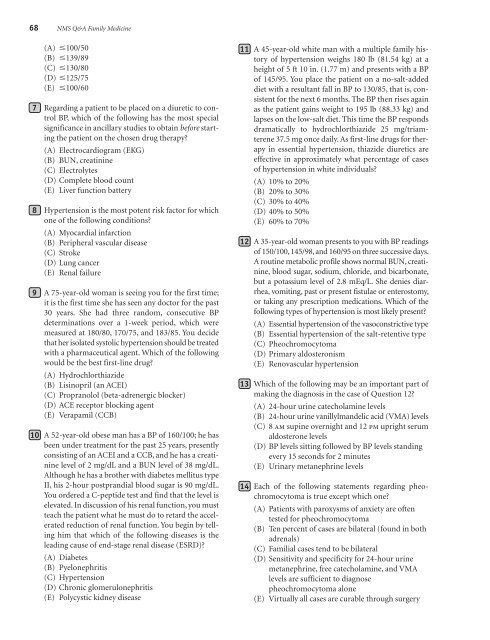NMS Q&A Family Medicine
NMS Q&A Family Medicine
NMS Q&A Family Medicine
- No tags were found...
You also want an ePaper? Increase the reach of your titles
YUMPU automatically turns print PDFs into web optimized ePapers that Google loves.
68 <strong>NMS</strong> Q&A <strong>Family</strong> <strong>Medicine</strong>(A) 100/50(B) 139/89(C) 130/80(D) 125/75(E) 100/607 Regarding a patient to be placed on a diuretic to controlBP, which of the following has the most specialsignificance in ancillary studies to obtain before startingthe patient on the chosen drug therapy?(A) Electrocardiogram (EKG)(B) BUN, creatinine(C) Electrolytes(D) Complete blood count(E) Liver function battery8 Hypertension is the most potent risk factor for whichone of the following conditions?(A) Myocardial infarction(B) Peripheral vascular disease(C) Stroke(D) Lung cancer(E) Renal failure9 A 75-year-old woman is seeing you for the first time;it is the first time she has seen any doctor for the past30 years. She had three random, consecutive BPdeterminations over a 1-week period, which weremeasured at 180/80, 170/75, and 183/85. You decidethat her isolated systolic hypertension should be treatedwith a pharmaceutical agent. Which of the followingwould be the best first-line drug?(A) Hydrochlorthiazide(B) Lisinopril (an ACEI)(C) Propranolol (beta-adrenergic blocker)(D) ACE receptor blocking agent(E) Verapamil (CCB)10 A 52-year-old obese man has a BP of 160/100; he hasbeen under treatment for the past 25 years, presentlyconsisting of an ACEI and a CCB, and he has a creatininelevel of 2 mg/dL and a BUN level of 38 mg/dL.Although he has a brother with diabetes mellitus typeII, his 2-hour postprandial blood sugar is 90 mg/dL.You ordered a C-peptide test and find that the level iselevated. In discussion of his renal function, you mustteach the patient what he must do to retard the acceleratedreduction of renal function. You begin by tellinghim that which of the following diseases is theleading cause of end-stage renal disease (ESRD)?(A) Diabetes(B) Pyelonephritis(C) Hypertension(D) Chronic glomerulonephritis(E) Polycystic kidney disease11 A 45-year-old white man with a multiple family historyof hypertension weighs 180 lb (81.54 kg) at aheight of 5 ft 10 in. (1.77 m) and presents with a BPof 145/95. You place the patient on a no-salt-addeddiet with a resultant fall in BP to 130/85, that is, consistentfor the next 6 months. The BP then rises againas the patient gains weight to 195 lb (88.33 kg) andlapses on the low-salt diet. This time the BP respondsdramatically to hydrochlorthiazide 25 mg/triamterene37.5 mg once daily. As first-line drugs for therapyin essential hypertension, thiazide diuretics areeffective in approximately what percentage of casesof hypertension in white individuals?(A) 10% to 20%(B) 20% to 30%(C) 30% to 40%(D) 40% to 50%(E) 60% to 70%12 A 35-year-old woman presents to you with BP readingsof 150/100, 145/98, and 160/95 on three successive days.A routine metabolic profile shows normal BUN, creatinine,blood sugar, sodium, chloride, and bicarbonate,but a potassium level of 2.8 mEq/L. She denies diarrhea,vomiting, past or present fistulae or enterostomy,or taking any prescription medications. Which of thefollowing types of hypertension is most likely present?(A) Essential hypertension of the vasoconstrictive type(B) Essential hypertension of the salt-retentive type(C) Pheochromocytoma(D) Primary aldosteronism(E) Renovascular hypertension13 Which of the following may be an important part ofmaking the diagnosis in the case of Question 12?(A) 24-hour urine catecholamine levels(B) 24-hour urine vanillylmandelic acid (VMA) levels(C) 8 am supine overnight and 12 pm upright serumaldosterone levels(D) BP levels sitting followed by BP levels standingevery 15 seconds for 2 minutes(E) Urinary metanephrine levels14 Each of the following statements regarding pheochromocytomais true except which one?(A) Patients with paroxysms of anxiety are oftentested for pheochromocytoma(B) Ten percent of cases are bilateral (found in bothadrenals)(C) Familial cases tend to be bilateral(D) Sensitivity and specificity for 24-hour urinemetanephrine, free catecholamine, and VMAlevels are sufficient to diagnosepheochromocytoma alone(E) Virtually all cases are curable through surgery
















